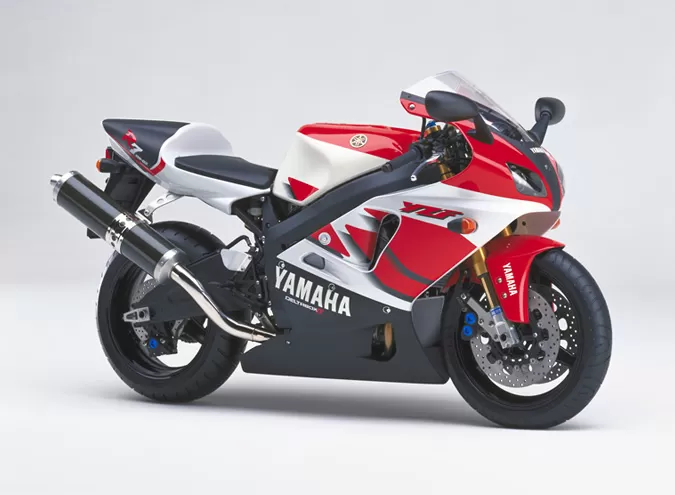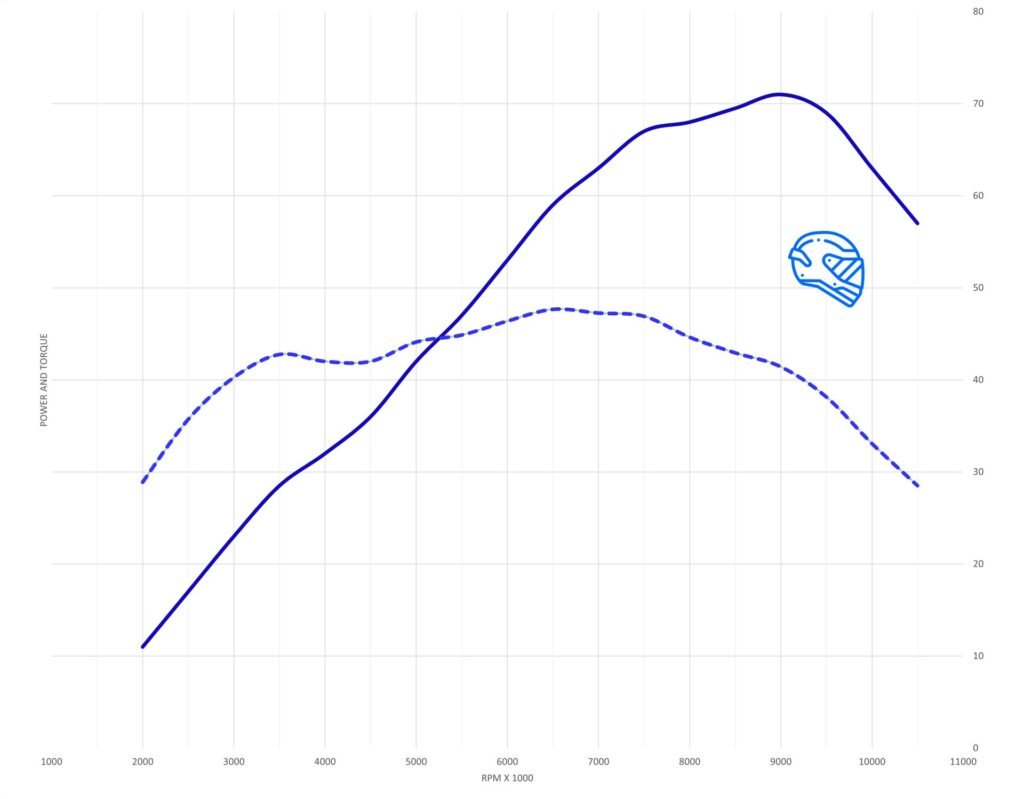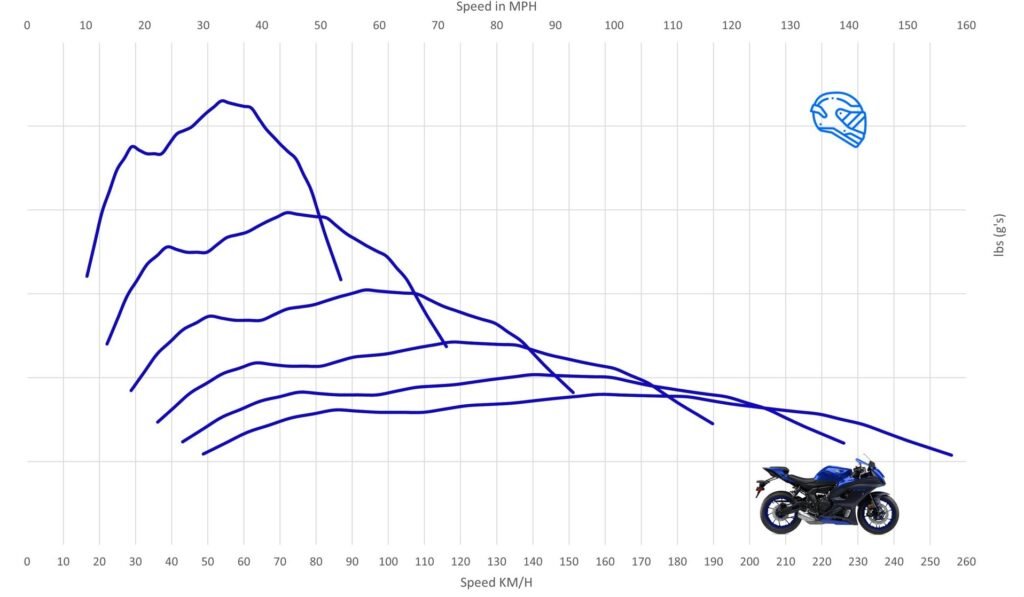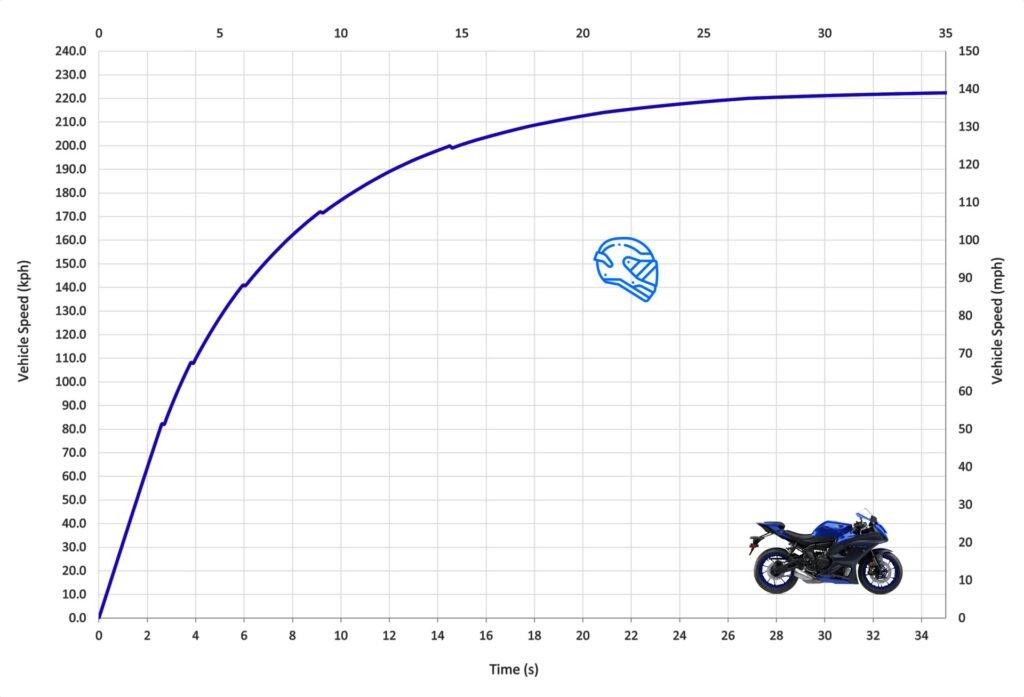Yamaha YZF-R7 0-60 mph in 3.27 seconds
Below, we take a look at Yamaha’s new R7 from 0-60 mph, quarter mile time, in-gear and outright acceleration through the gears and its top speed.
The Yamaha YZF-R7 is a sports motorcycle based heavily on the hugely popular Yamaha MT-07. A motorcycle that is of great value that offers exceptional performance.
Yamaha’s MT-07 is an absolute gem of a motorcycle and has arguably one of the best sub 700 cc engines of recent times.
It makes sense to use it elsewhere and not in just naked or adventure motorcycles such as the Tenere 700 or XSR 700.
Interest in radical uncompromising Supersport 600s vanished along with their development!
Also, riders’ tastes for more practical, cheap, and accessible sports motorcycles that still perform well have increased.
Yamaha of course had the great idea to build a sports motorcycle around that fantastic 689 cc parallel two engine that is used in the Yamaha MT-07, XSR 700, and Tenere.
The purest might not be quite so happy with the naming of the new YZF-R7.
People old enough will remember the Yamaha YZF-R7 that Noriyuki Haga rode in World Superbikes back in 1999 and early thousands.

The original Yamaha YZF-R7 is nothing like the new model. Instead being powered by a 749 cc Inline four.
With the race kit, it would also be more than twice as powerful as the new YZF-R7.
Perhaps the new YZF-R7 should have had an S at the end of it for ‘street’ or similar.
The Yamaha YZF-R7 actually is a replacement for the YZF-R6, though it has a lot of new riders confused.
Normally larger corresponding numbers in motorcycle naming schemes denote a larger engine (which is true) and the larger number in the name also means more power, especially in a family series of motorcycles.
| YZF-R Series | |||||
| R125 | R25 | R3 | R6 | R7 | R1 |
The Yamaha YZF-R7 is less powerful than the YZF-R6 though to be fair the YZF-R6 is discontinued now in many markets and only is available in a race version not for the road.
So technically the series if we exclude the YZF-R6 is consistent in its engine size and power increments.

Yamaha YZF-R7 Dyno Curve
The new Yamaha YZF-R7 uses the same but a revised CP2 engine as the Yamaha MT-07. So, we have the familiar 689 cc parallel two making a claimed 72 horsepower at the crank.
It’s a fantastic engine known best for its instantaneous grunt regardless of where the needle sits in the rev range.
Those numbers equate to a little over 100 horsepower per litre which is not a lot by motorcycle standards though this is intended and should not be seen as a negative.
At the rear wheel, the new YZF-R7 produces a very healthy 71 horsepower at 9000 rpm, though typically you will see 67-68 horsepower but you may get a good healthy one.
71 horsepower may not sound a lot if compared to competitors such as the CBR650R or RS 660, or in general but the YZF-R7 is more about torque which is at 47 ft/lb and is a good number for the class.
Again, though you may be thinking that 47 ft/lb is not that impressive but don’t be fooled.
Just like the MT-07 engine, the YZF-R7 engine is much more impressive than what it says or puts down on paper.
This is by and large due to a great spread for torque starting from 3000 rpm and combined with relatively low gearing. (More on that later)

Yamaha YZF-R7 gear acceleration
The R7 and its engine is not a motorcycle that needs to be screamed through the gears nor is it necessary to have lots of rpm showing on the tachometer if you want a good response from the engine.
When pootling about you can use higher gears and have the rpm between 3000-5000 rpm and still have plenty of acceleration when you need it.
If you’re blasting about and chasing friends, you can keep them in sight shifting only at 6000-7000 rpm and as far as 9500 when you really have to get a move on.
You don’t need to be than taking the engine into the red like you might do with some other motorcycles without losing much in a straight line.
As already mentioned, you can even short-shift at 6000-7000k and still make rapid accelerative progress.
The new R7 is geared a fraction longer than the MT-07 and is a few kilograms heavier.
This means that technically it will have slightly slower in-gear acceleration, but to be honest, it is not something that you would notice too much as we are only talking one tooth difference at the rear sprocket.
Also, consider that the Yamaha YZF-R7 has more than enough mid and bottom-end grunt to pull higher gearing and is a class up there at the top in class for its in-gear performance.
For example, In the first three gears anywhere below 8000 rpm the new R7 will out grunt the new Aprilia RS 660 while matching it in fourth and losing out in fifth and sixth gear. (Comparison HERE)
Speed in gears at 5000rpm
| Speed at 5000 rpm | YZF-R7 |
| Speed 1st Gear | 25.6 mph |
| Speed 2nd Gear | 34.3 mph |
| Speed 3rd Gear | 44.7 mph |
| Speed 4th Gear | 56.1 mph |
| Speed 5th Gear | 66.9 mph |
| Speed 6th Gear | 75.7 mph |
Of course, the RS660 has more ‘go’ above 8000 rpm in any gear as the R7’s power curve starts to flatten off while the RS 660 goes on to produce almost 20 more horsepower.
Either way, just like the MT-07, the YZF-R7’s engine and performance work really well under 100 mph and blasting from one slow corner to the next.
Blasting around town is also great fun with its easily accessible grunt where it is very effective against competitors, even the CBR650R that is powered by a 649 cc inline 4.
Yamaha YZF-R7 Acceleration and top speed
If you have ridden an MT-07 you can expect straight-line performance to be in the same ballpark as the new R7, just a little less frantic.
The YZF-R7 is a touch heavier than the MT and Yamaha – as mentioned earlier has opted to lengthen gearing a little bit over the MT-07.
The assumption would be that it might hurt the acceleration of the R7 if compared to the MT-07 but this is not the case.
From a dig, the R7 is consistently faster as it is a little easier to launch and slightly less wheelie prone than the MT-07 despite having a shorter wheelbase.
That little extra weight, plus the longer gearing probably helps somewhat.
Then if we combine that with the sportier riding position of the R7 that ensures there is little more weight over the front which helps no doubt to tame the tendency to wheelie.
When all added up means more consistent times and better PBs when push comes to shove.
With that said the Yamaha YZF-R7 hit 0-60 mph in 3.27 seconds and 0-100 km/h in 3.43 seconds.
The benchmark to 60 mph requires a gear change, though thanks to the quickshifter less time is lost on the upshift to second gear.
The dash to 100 mph is pretty rapid for a seventy-horsepower motorcycle too, arriving in only 7.88 seconds.
The Yamaha YZF-R7 needs fourth gear like many motorcycles in this class due to the lower rev ceiling which hinders potential top speeds in each gear.
The Yamaha YZF-R7 is faster than Kawasaki’s similar Ninja 650 as seen here convincingly but is a little slower outright compared to the Aprilia RS 660.
Up against the YZF-R6 you can see how the YZF-R7 compares via the comparison for yourself R7 vs R6.

The Yamaha YZF-R7 hit a 139 mph top speed
Just like its ugly sister, the Yamaha R7 can dip into the 11’s on the drag strip.
It’s a lot harder on the MT-07 but the R7 manages mid 11s scoring 11.64 seconds on the quarter-mile run with a terminal speed of 116 mph.
This is a great time but is certainly very close to the pinnacle.
Most decent lightweight road riders would be low 12s and if you’re rubbish at launching low to mid 13s.
Like with all mid to low-power motorcycles that 1/8th mile time is key as you don’t have 200 horsepower to make up lost time from the start for your lack of skill or lack of power of the motorcycle.
If you must see what she is capable of you’ll be pleased to know that the YZF-R7 can hit a top speed of 139 mph if you are of small stature and very committed.
The R7 is very svelte and has a tiny frontal area and is overall very narrow, which is helped by that very slim parallel two-cylinder engine.
The hardest part is keeping elbows out of the wind due to the narrowness of the Yamaha YZF-R7.
As with many motorcycles in recent times, I’m told US models have a few more throttle restrictions in the ECU, so if you have a US motorcycle your top speed may vary as well as your acceleration times.
Typically, a real-world top speed on the Yamaha YZF-R7 for most average people would be low 130s unless you have great conditions, are small, and can tuck very effectively.
You must also be able and willing to have it pinned for at least a mile if attempting from a standing start.
The difference between a good tuck versus a poor tuck added 5 seconds to the 0-130 mph time.
So, if you are racing your mates be sure to use our Yoga skills for the best effect otherwise the wind will really hold you back.

Yamaha YZF-R& Acceleration through the gears
| Yamaha YZF-R7 Acceleration And Top Speed | |
| Speed | Time |
| 0-10 mph | 0.34 |
| 0-20 mph | 0.96 |
| 0-30 mph | 1.48 |
| 0-40 mph | 2.00 |
| 0-50 mph | 2.54 |
| 0-60 mph | 3.27 |
| 0-70 mph | 4.10 |
| 0-80 mph | 5.07 |
| 0-90 mph | 6.35 |
| 0-100 mph | 7.88 |
| 0-110 mph | 10.00 |
| 0-120 mph | 12.86 |
| 0-130 mph | 18.26 |
| 60-130 mph | 14.72 |
| SS/QM | 11.64 @116 mph |
| SS/KM | 22.15 @ 134 mph |
| SS/Mile | 32.03 @ 138 mph |
| Top Speed | 139 mph |















